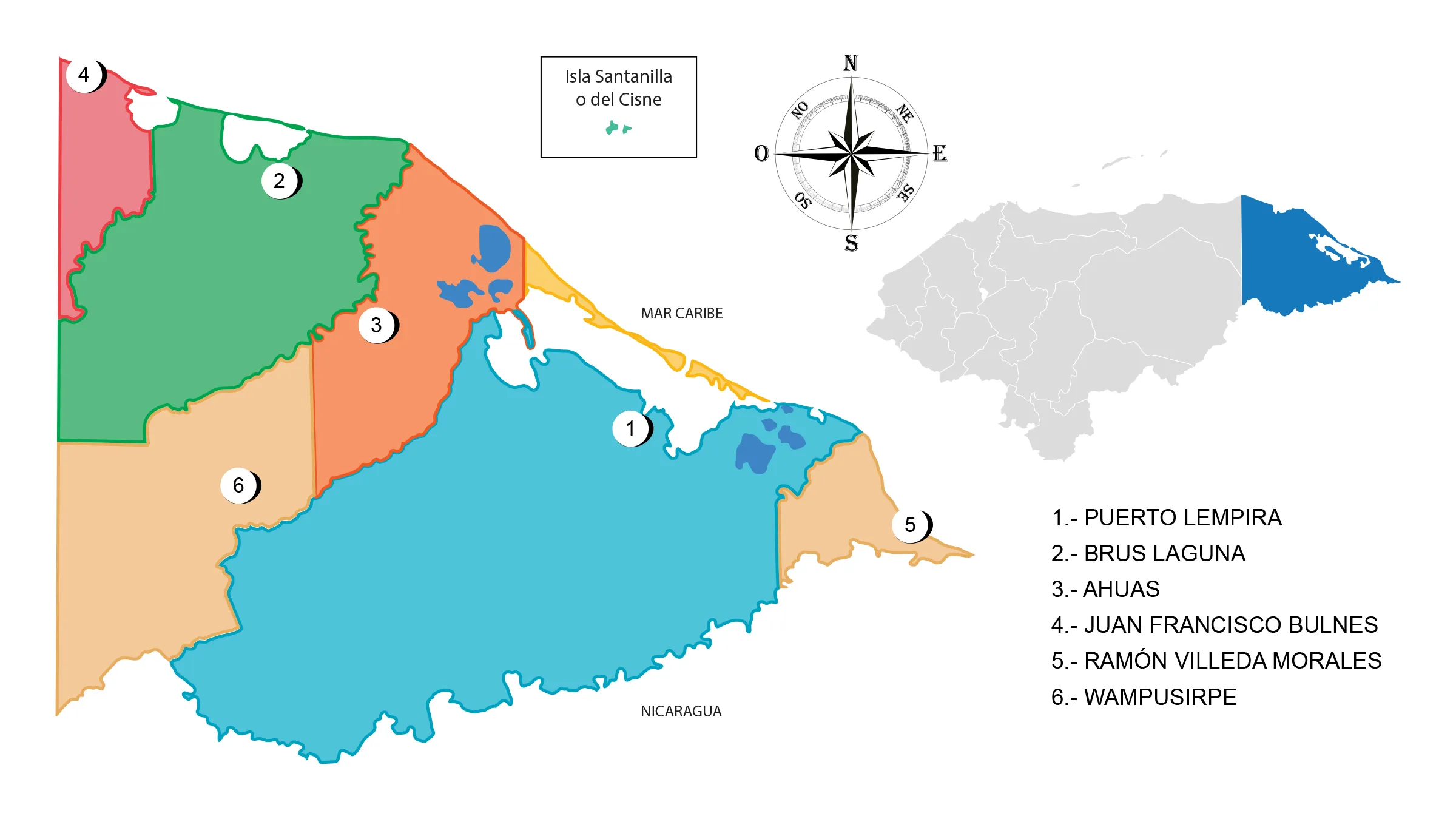Department of Gracias a Dios

Gracias a Dios is one of the 18 departments that comprise the territory of the Republic of Honduras, with Puerto Lempira as its capital. The majority of this territory is known as the Mosquitia.
View Map of Department of Gracias a Dios
General Information
Origin of its name: Exclamation of Christopher Columbus when rounding a cape of Honduras to escape a storm. Traditional oral history collected by Vallejo.
It borders the Republic of Nicaragua to the north, and the departments of Colon and Olancho to the west.
In 1982, UNESCO declared the Río Plátano Biosphere Reserve a world heritage site.
Located in the Río Plátano basin, this reserve houses one of the rare remnants of Central American tropical rainforest. Its fauna and flora are abundant and varied.
In its mountainous territory, which descends in slope to the Caribbean coast, live more than 2,000 indigenous people who have preserved their traditional way of life.
- Departmental capital: Puerto Lempira
- Land area: 16997 km2
- Population: 93,441 inhabitants (2012)
- Population density: 5 inhabitants/km2
- Creation date: February 21, 1957
History of Gracias a Dios
Aside from the Tawahkas who inhabited the Taguzgalpa region, there is no information about other native groups in the pre-Hispanic era in the region; however, there is archaeological and ethnological evidence of groups belonging to the intermediate cultural area or circum-Caribbean.
Upon the arrival of the Spanish in the 16th century, the region served as a refuge for natives from the north and east, who, along with black slaves, were fleeing the Spanish conquest process. Attempts to militarily and spiritually colonize Taguzgalpa were postponed due to the region’s impenetrability and the little importance it represented for the crown.
With the establishment of the Miskito ethnicity in the 16th and 17th centuries, the region was populated and later became known by the name La Mosquitia.
In the middle of the 18th century, the English established commercial controls in Honduran Mosquitia, one of the main ones being Black River, where English products entered and local products left via smuggling.
The current department of Gracias a Dios belonged to the department of Yoro after the independence from the Spanish crown, then it became the department of La Mosquitia created on May 26, 1869, then it became part of the department of Colon in 1881.
The department is home to reserves, biospheres, and the Plátano river, true sources of oxygen and water. The department was re-created and separated from Colon on February 21, 1957, by the military government board.
Geography of Gracias a Dios
It is located at the extreme east of the country.
Boundaries
- North: Antillean Sea;
- South: Republic of Nicaragua;
- East: Antillean Sea;
- West: Departments of Olancho and Colon.
Municipalities of Gracias a Dios
See List of Municipalities of Honduras
- Puerto Lempira 0901
- Brus Laguna 0902
- Ahuas 0903
- Juan Francisco Bulnes 0904
- Ramón Villeda Morales 0905
- Wampusirpe 0906
Rivers: Coco or Segovia, Kruta, Warunta, Patuca, Plátano.
Lagoons: Caratasca Lagoon, Brus, Ibans or Ebano, Warunta, Tansin, Laguntara, Kohunta, Tilbalakán, Cauquira, and Rapa.
Mountain ranges: Sierra de Warunta
Mountains: Mountain of Colon
Protected Areas
National park, Kruta river and Sierra de Warunta; forest reserve, Mocorón; reserve, Río Plátano biosphere, Tawahka; biological reserve, Caratasca lagoon and Rus Rus.
Fauna and Flora of Gracias a Dios
Mammals: Shrew, squirrel, coati, guazalo, skunk, raccoon, deer, tapir or danto, tepezcuinde, sloth, wild pig, coyote, fox, wildcat, puma, ocelot, jaguar, and manatees.
Birds: Woodpecker, forest pheasant, dove, roadrunner or dog’s soul, magpie, blackbird, quail, torcasa, parrot, taragon or guardabarranco cenzonde, finch, hawk, vulture, owl, and osprey.
Marine species: Crab, lobster, shrimp, jaiba, manta ray, and a variety of fish.
Flora: Broadleaf forests, mixed and coastal pine forests in the savannahs.
Economy of Gracias a Dios
Production: Cultivation of pineapple, cassava, and basic grains; raising of cattle, horses, pigs, and goats; industry: exploitation in mining resources and fishing.
Commerce: Puerto Lempira and Brus Laguna.
Mines: Gold in the Honduran Continental Shelf and the probable presence of hydrocarbons.
Tourism in Gracias a Dios
- Río Plátano Biosphere Reserve – World Heritage Site
- Caratasca Lagoon Complex
- Puerto Lempira
- Barra Patuca.


